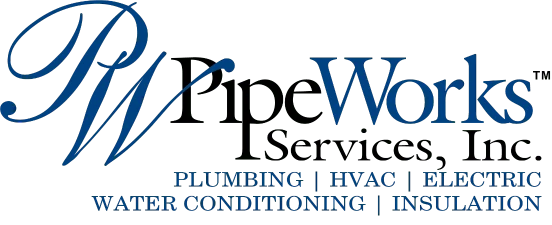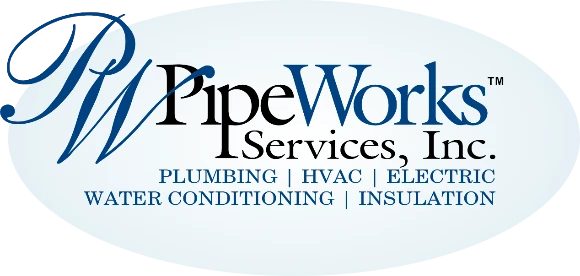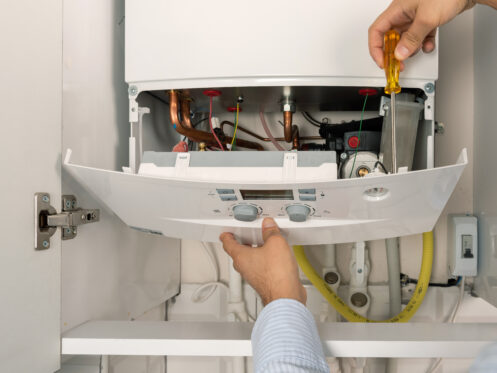Although the majority of homes in the United States have furnaces and forced-air heating systems, it’s not all that uncommon for older homes in some areas to have a steam boiler and radiant heating instead. Steam boilers are even more commonly used for commercial and industrial applications as well as older school buildings and hospitals. Although steam boilers aren’t as energy efficient as other heating appliances, they’re capable of providing extremely effective heating while also maintaining consistent temperatures across an entire building. We’ll take an in-depth look at how steam boilers and radiant heating work and discuss the things you need to know to choose the right boiler for your home.
How Steam Boilers and Steam Heating Work
A boiler is simply a device that heats water so that it can then be used to provide radiant heating. Standard boilers typically heat the water to somewhere between 120 and 180 degrees and then use a pump to circulate the hot water throughout the radiant heating system. Steam boilers, on the other hand, heat the water until it boils and turns into steam. The steam then naturally rises from the boiler’s pressure tank and flows out through a series of pipes that lead to each of the radiators in the building.
There are a variety of different types of steam boilers, but they all work using the same basic process. Most steam boilers have a combustion system and a burner that burns natural gas, propane or heating oil to produce extremely hot combustion gases. These gases flow through a heat exchanger that transfers much of the heat to the water within the pressure chamber so that it quickly boils and produces steam. There are also electric steam boilers that instead use electric resistance heating elements to cause the water to boil.
Some radiant heating systems with a steam boiler are single-pipe systems. In this type of system, each radiator has a vent that lets out a small amount of steam once the radiator gets fully hot. You can use the vent to adjust the temperature of the radiator so that it doesn’t get too hot. In a single-pipe system, the condensate water that forms when the steam cools down eventually ends up traveling back down to the boiler through the same pipe the steam traveled up. In this case, you actually have water and steam flowing through the pipe in opposite directions whenever the boiler is on.
Two-pipe systems instead have an additional pipe on each radiator to carry the condensate water, which forms when the steam cools down, back to the radiator. Two-pipe systems are generally a bit more effective and energy efficient. In a single-pipe system, the steam can end up losing some heat as it contacts the condensate water. The result is that it takes a bit longer for each of the radiators to fully heat up.
An Overview of Radiant Heating
Although radiant heating takes a bit longer to heat a space compared to forced-air heating, it works much more consistently and provides more even temperatures. Instead of just heating air and moving it around the house, radiant heating heats surfaces and objects inside it, such as the walls, floors, and furniture. Heat then continually radiates off these surfaces to warm the air and heat the entire room from top to bottom. This is one major advantage that radiant heating has over forced-air heating: You don’t just end up with all the hot air quickly rising and settling near the ceilings.
Radiant heating systems in older buildings almost always have one or more radiators or baseboard heaters in each room. Radiators are most commonly located just below windows so that the heat radiating off of them essentially creates a barrier that blocks cold air coming in through the windows. In newer homes that have radiant heating, it’s more common to have coils located underneath the floor in each room as well as a few radiators or possibly in-wall heating units or baseboard heaters.
Under-floor radiant heating systems typically use a hot water boiler instead of a steam boiler since you want only hot water, not steam, flowing through the underfloor coils. Nonetheless, it is possible to retrofit an existing steam boiler to work with underfloor radiant heating by adding a secondary heat exchanger that just creates hot water instead of steam and then setting up your underfloor heating on a different zone from your steam heating.
How to Know Which Type of Boiler Is Best for You
If you currently have a steam boiler that you need to replace, one option is just to install a new boiler of the same type. However, you can usually convert an older radiant heating system from steam to hot water. While this will cost more than just installing a new steam boiler, it can end up saving you quite a bit of money in the long run. That’s because a condensing hot water boiler will always be more energy efficient and cost you less to operate than a steam boiler.
The efficiency of a boiler is expressed in its annual fuel utilization efficiency (AFUE) rating, which merely measures the percentage of energy a boiler uses that it converts into heating. The best steam boilers are typically rated no more than 80% to 86% AFUE, whereas any condensing hot water boiler will be rated at least 90% AFUE, and the best units are rated around 98% AFUE. The improved efficiency means you should eventually save enough on your energy bills to recoup the cost of converting from steam to hot water heating.
Another thing you may want to consider instead of installing a standard boiler is a combination boiler. Often referred to as combi-boilers, these units are unique in that they can also supply hot water to your plumbing system. Any other type of boiler, on the other hand, can generally be used only for radiant heating. That means you’ll obviously need to have a separate water heater for your plumbing. A combi-boiler is quite similar to a tankless water heater and only runs on demand. That means the only time the unit will come on is when your thermostat signals it to start supplying heat or you start running hot water at a sink, shower, or other outlet. This is a major benefit compared to standard water heaters and boilers since you don’t end up with the same amount of energy waste.
If you’re searching for a reliable, experienced home service company, Pipe Works Services is the one to turn to. We’ve been serving customers in Chatham and throughout Northern and Central New Jersey for nearly 25 years and have an outstanding reputation for providing quality work at honest prices. If you need to install a new boiler or your unit needs any repairs or maintenance, you can trust our team to handle everything professionally and get the work done as soon as possible. We also work with central HVAC systems and can take care of your furnace, air conditioning, or heat pump needs.
For more information on our boilers services or to schedule any HVAC, electrical, plumbing or heating installation service, contact us at Pipe Works Services today.





